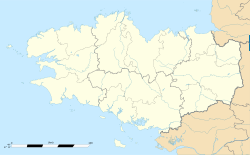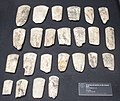You can help expand this article with text translated from the corresponding article in French. (October 2012) Click [show] for important translation instructions.
|
| Saint-Michel tumulus | |
|---|---|
 | |
| General information | |
| Location | Carnac, Brittany, France |
| Coordinates | 47°35′16″N 3°04′25″W / 47.5879°N 3.0735°W |
| Year(s) built | c. 4500 BC |
| Height | 10 meters |
| Dimensions | |
| Diameter | 125 meters |
| Technical details | |
| Material | Stone |
The Saint-Michel tumulus (Breton: tumulus Sant-Mikael) is a megalithic grave mound, located east of Carnac in Brittany, France.[1] It is the largest grave mound in continental Europe.
History
[edit]
The tumulus was built during the fifth millennium BC. It consists of a mound of earth and stones 125 metres (410 ft) long, 50 metres (160 ft) wide and 10 metres (33 ft) high.[1] Explored in 1862, researchers found a central vault containing fairly prestigious funerary furniture: axes, pearls, flint tools, and sillimanite.
On 27 June 1795, the site served as the setting for the Battle of Saint-Michel Tumulus between the French and the British during the Great French War.
It has been classified as a "Monument historique" (National heritage site) since 1889.
Around 1900, the archaeologist Zacharie Le Rouzic again excavated the Saint-Michel tumulus and discovered a second dolmen and fifteen small stone chests, thus revealing the complexity of this monument.
Gallery
[edit]- Saint-Michel tumulus plan by Zacharie Le Rouzic
- Excavation entrance to the tumulus
- Finds from the Saint-Michel tumulus
- Jade axes from the tumulus
- Callais necklace from the tumulus
- Broken stone axes from the tumulus
References
[edit]- ^ a b "Saint-Michel tumulus". www.megalithes-morbihan.com. Retrieved 6 November 2014.


 Français
Français Italiano
Italiano





![Saint-Michel tumulus plan by Zacharie Le Rouzic [fr]](http://upload.wikimedia.org/wikipedia/commons/thumb/c/c3/132_Plan_du_tumulus_Saint-Michel.JPG/120px-132_Plan_du_tumulus_Saint-Michel.JPG)








